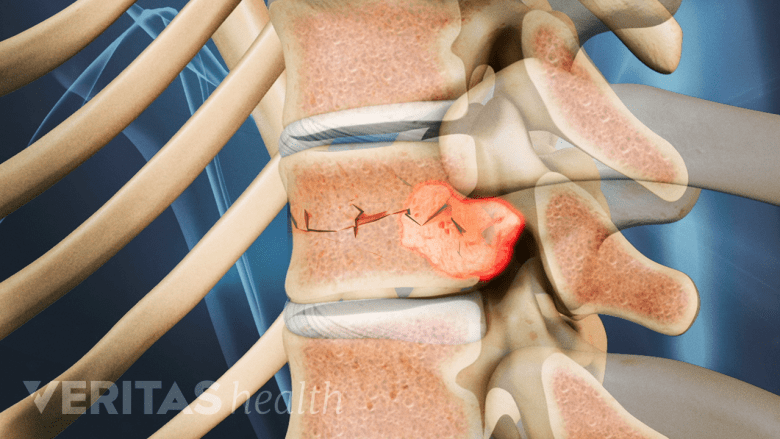Vertebroplasty is widely considered a relatively safe procedure for reducing pain caused by a vertebral compression fracture, but it is still surgery and has some risks. While the complication rate for vertebroplasty is estimated at less than 4%, some of the risks can be serious and need to be considered before making a decision about surgery.
In This Article:
- Vertebroplasty After a Painful Spine Fracture
- Vertebroplasty Procedure
- Vertebroplasty Risks and Potential Complications
- Vertebroplasty Procedure Video
Potential Complications in Vertebroplasty
All surgeries that are performed inside the body and involve medication include some serious risks, including infection, allergic reaction, and excessive bleeding. Other potential complications of vertebroplasty include:
- Cement leakage. This issue can occur when the bone cement leaks outside of the intended vertebral compression fracture’s cracks. Fortunately, there are rarely any complications associated with bone cement leaking outside of the fracture, especially if it is a small amount. However, it is possible for bone cement to leak onto a nerve root or the spinal cord, which could increase pain, tingling, numbness, and/or weakness, as well as possibly cause problems with function and movement. There have also been reported cases of bone cement getting into a vertebral vein and causing problems, such as a pulmonary embolism (artery obstruction in the lung).
- Paralysis. Vertebroplasty is performed near the spinal cord and other important nerves, so an error in the needle’s placement could potentially result in damage that causes weakness and/or paralysis of one or more limbs.
- Failure to reduce pain. Sometimes vertebroplasty does not improve symptoms, even if no errors or complications occurred during the procedure.
This is not a complete list of possible vertebroplasty complications. Also, it is not yet known whether vertebroplasty or kyphoplasty increases the risk of another fracture in the spine or ribs, but it is known that a patient sustaining an osteoporotic fracture is already at risk for additional fractures.
Vertebroplasty Risk Factors

Vertebroplasty has limited success in treating cancer-related vertebral compression fractures.
Many factors can increase the risk of having an unsuccessful vertebroplasty, such as:
- Delayed procedure. If a vertebroplasty is not done within 8 weeks of the initial fracture, the procedure is less likely to provide significant pain relief compared to nonsurgical treatment methods. One possible reason may be that the fracture is more likely to have started to heal after a couple months.
- Lower-quality fluoroscopy equipment. One of the most important aspects of vertebroplasty is the surgeon’s ability to see the location of the needle as it enters the body and gets placed into the damaged part of the vertebra. There is some evidence that when lower-quality fluoroscopy equipment is used, such as the portable versions commonly found in hospital operating rooms, vertebroplasty complication rates may go up.
Compression fracture caused by cancer. When vertebroplasty is performed for vertebral compression fractures caused by cancer, the complication rate is about 10%. By comparison, the vertebroplasty complication rate is only about 4% for compression fractures caused by osteoporosis.
Other risk factors for vertebroplasty exist, such as the surgeon’s experience level and the shape of the fracture.

